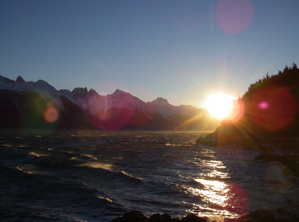The Winter Solstice is upon us. On December 21st this year (it varies slightly) in the northern hemisphere, it’s the longest night of the year, literally midwinter’s night—not “the first day of winter” as modern calendars so obtusely term it. Human kind has observed this night with ritual and celebration since prehistoric times.
We moderns, from our smug worldview, like to think of this tradition as one of fear and ignorance. Most descriptions of Winter Solstice rites speak in terms of panic and doubt. Ancient, unenlightened men, we delight in assuring ourselves, were afraid the sun would not return, and lit their fires and performed their rites to try to force it to do so.
I doubt this. These people may not have been educated in modern science, but they were hardly stupid. They lived as one with Nature, in tune with its rhythms and cycles in ways that modern man can scarcely imagine. No doubt their knowledge and traditions assured them that the sun would rise every day without fail, and would seasonally fluctuate between solstices. True, they may not have understood the mechanics of Earth’s angled axis tilting their part of the world toward or away from the sun depending on the season, but the regularity of these events could hardly be lost on them. In fact, research on Stonehenge, a site for these fearful rites in popular imagination, has indicated that it is actually a carefully laid-out and mathematically precise “calendar” to mark periodic fluctuations in the orbits of the earth and moon around the sun. The idea that these cultures could be surprised and distressed every single year by the longest night is laughable.
Rather than desperately doing whatever they could to “make the sun come back,” I suspect that their rites either acknowledged the turning point between darkness and light, or “helped” nature make this change, ritualistically participating in the process. This too may seem naive from a modern point-of-view, but what is prayer if not this same effort on a personal or congregational level? Perhaps we are too quick to condemn and belittle.
Whatever the true motivation, I delight in joining my ancestors in marking the solstices, particularly the Winter Solstice. It is a milestone in the circle of the seasons, an originating and still-important aspect of our Christmas holiday. By observing it, I am communing with all those who came before me.
I love darkness! I find it to be comforting and cozy, but more importantly, it’s the essential condition for Christmas light. Christmas candles, oil lamps, strings of tree and house lights, luminarias all require darkness in order to be effective, so I say, the more darkness the better!
Loving darkness is very convenient, living in Alaska. We are not so far north that we have total darkness for months at a time, as do northern regions of the state, but at the Winter Solstice we get only six hours, six minutes of official daylight. Positioned as we are on the east side of a ridge, with a mountain range facing us across the fjord, we actually get far less light than that. Our log cabin’s bare wood walls, floors and ceilings make our home even darker.
This allows lots of time to indulge in Christmas lights! At Christmas, we use our light bulbs less, relying more on the light of the Christmas tree or branch, our candles, and the mellower glow of oil lamps. True, we usually carry a headlamp to illuminate tasks as needed, but mostly we bask in the Christmas glow, celebrating the darkest time of year rather than fearing it or wishing it away.
Perhaps what we’re really celebrating is balance. This is a very pagan concept for someone raised as a Christian—modern Christianity eschews balance, it seems. The Christian worldview is so black and white, and “good Christians” crowd on the far side of white, avoiding black at all costs. A sense of balance seems to make more sense to me: happiness needs sadness as a measure to compare against. Wakefulness requires restorative sleep. Labor and rest must balance, as must work and play, hunger and fullness, laughter and tears, and—especially at this time of year—light and dark.

